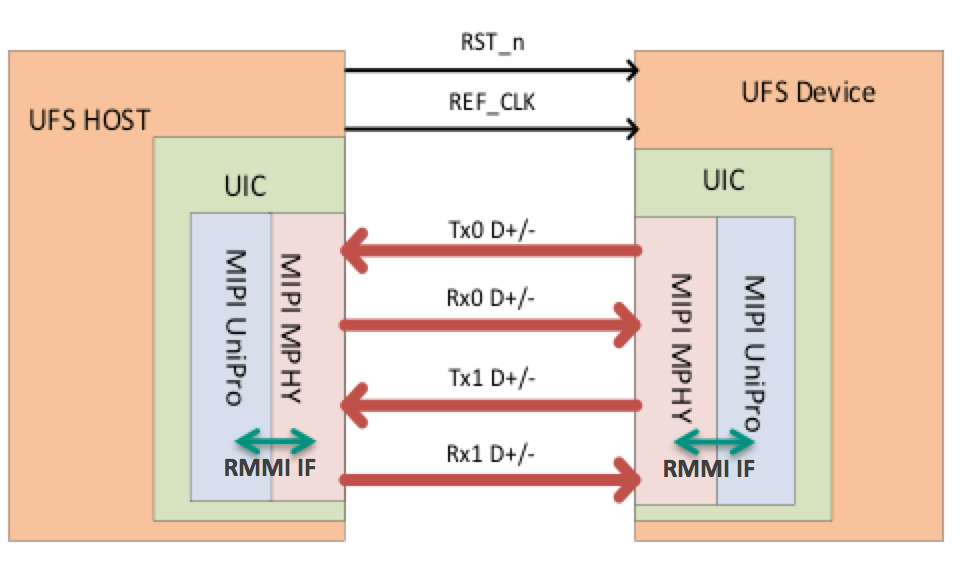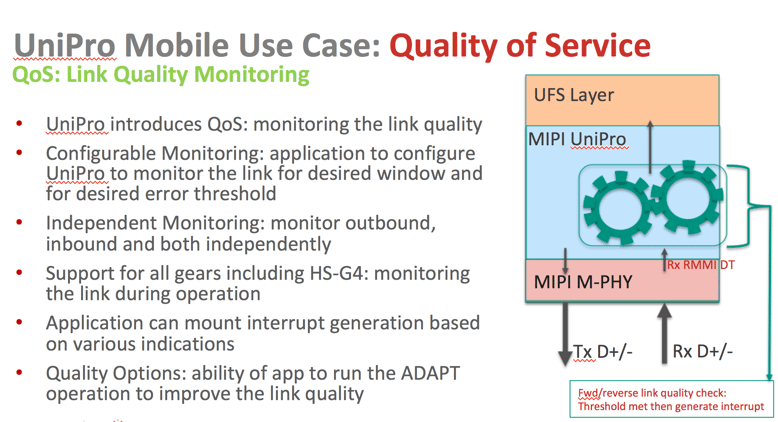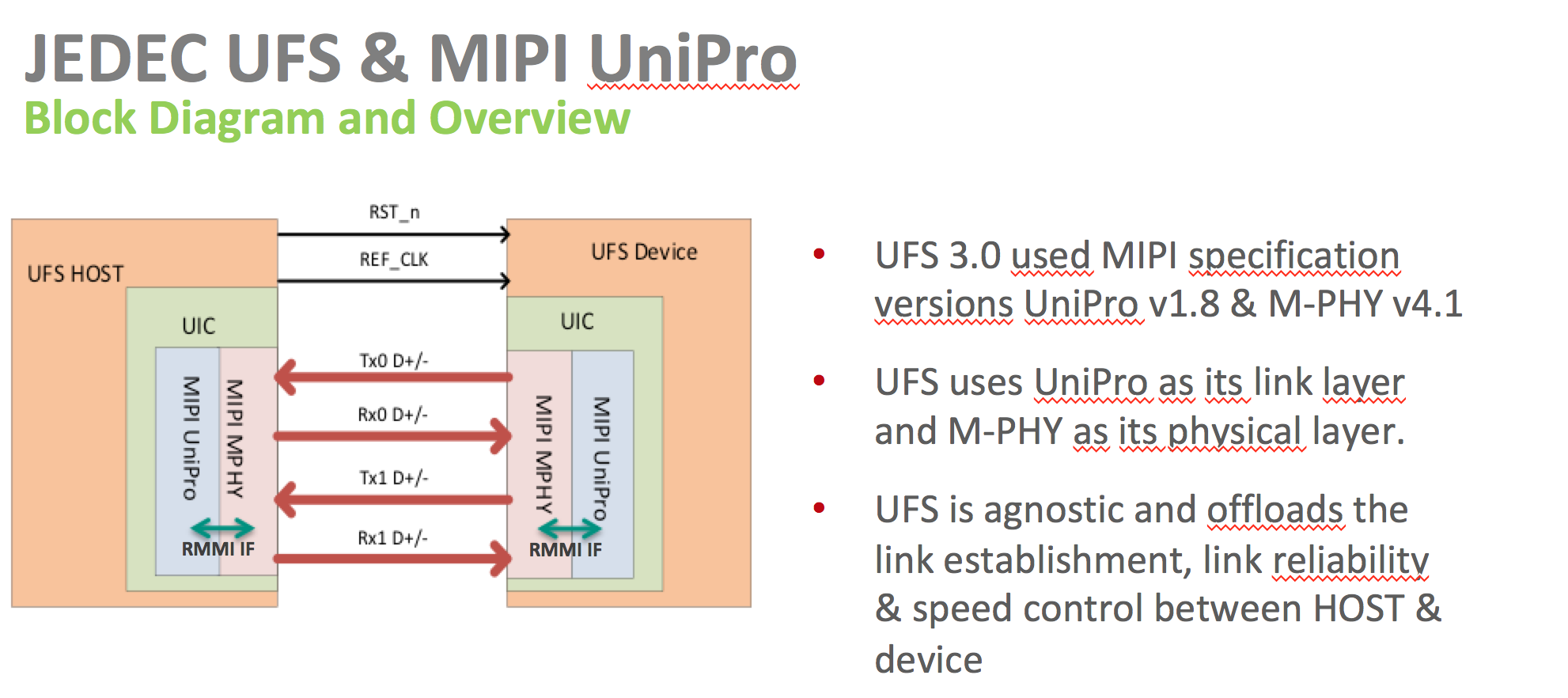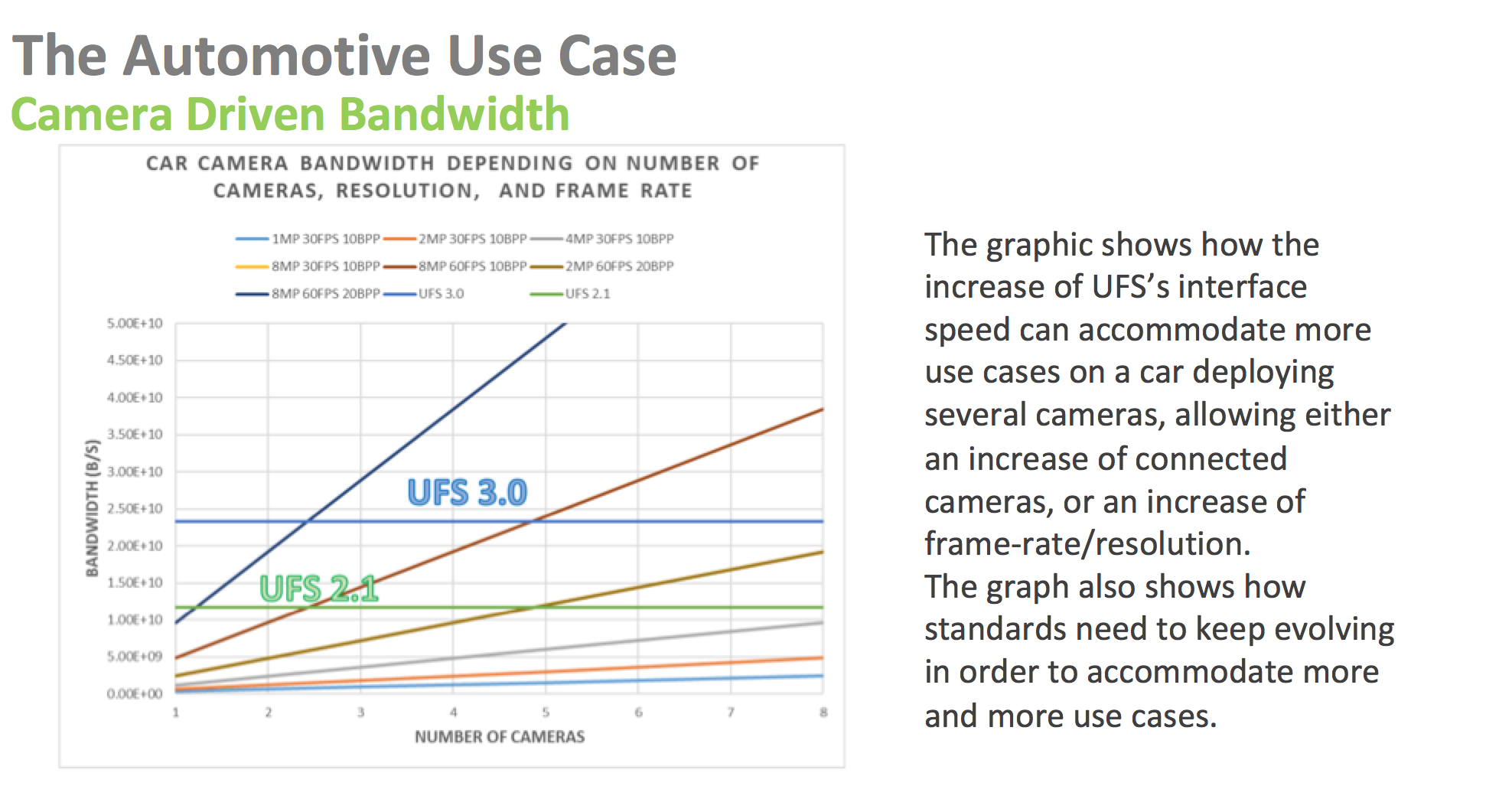4 min read
How MIPI M-PHY and UniPro Will Power Next-Generation Use Cases for Mobile and Beyond
![]() Ramesh Hanchinal, Chair of the MIPI UniPro Working Group
:
18 December 2018
Ramesh Hanchinal, Chair of the MIPI UniPro Working Group
:
18 December 2018

- News & Events
- News
- Blog
MIPI's M-PHY® v4.1 and UniPro® v1.8 specifications feature powerful innovations that increase the performance and quality of mobile device interconnects. In flash storage interconnects, the M-PHY physical layer and UniPro link layer form an ideal combination.
Let's take a look at a few use cases for these specifications.
Double the performance
M-PHY v4.1 and UniPro v1.8 offer twice the speed per lane than was available in their previous generations. Developers can take advantage of this breakthrough in the following ways:
- Higher top speed
- M-PHY v4.1 features HS-G4 (High Speed GEAR 4), which was introduced with M-PHY v4.0 and is now supported in UniPro v1.8. This mode allows developers to build interfaces with speeds up to 11.7 Gbps per lane – twice the 5.8 Gbps speed of previous generations.
- UniPro v1.8 initiates power mode changes to expand the M-PHY v4.1 physical layer from two to four lanes and from the standard 5.8 Gbps speed to HS-G4. When using a power mode that provides two lanes in each direction, the speed will be approximately 23 Gbps per direction, for a total throughput of about 46 Gbps.
- Improved efficiency
- For applications that don't require the full 23 Gbps per direction, the higher per-lane speed allows for sufficient performance with fewer lanes than would otherwise be necessary.
- For example, with the 5.8 Gbps top speed available before HS-G4, achieving 11.7 Gbps per direction would have required two lanes. Accomplishing this with just one lane significantly cuts costs.
5G readiness
The higher performance of HS-G4 will help handset developers meet the requirements of 5G phones.
As 5G accelerates cellular connections and enables new multimedia and VR/AR applications, more handsets are expected to incorporate large flash drives of 256 GB or more, up from the typical 32 GB or 64 GB today. M-PHY v4.1 and UniPro v1.8 allow multiple applications to use a flash interface simultaneously in a multiplex fashion, meeting users' needs for all the applications.
Quality of service
While increasing link performance by changing power modes, UniPro v1.8 also ensures that link quality remains consistent. This QoS functionality can be used in several ways:
Figure 1:

Figure 1: UniPro 1.8 performs link QoS functions within flash interfaces, in this case a UFS 3.0 interface. Communicating with M-PHY via RMMI, the UniPro link layer can monitor the forward and reverse links independently and generate interrupts if a configurable threshold for errors is exceeded.
- Configurable monitoring
- UniPro monitors the bit error rate of a link by communicating with the M-PHY physical layer via RMMI. UniPro counts events such as NAC and CRC error frames and compares these against the number of correctly received or transmitted bytes. When the number of errors exceeds a set threshold, it initiates an attempt to repair the link through an action such as an equalization or ADAPT operation. When it has made a number of link-repair attempts, UniPro can also send a notification to the application layer, which can analyze the problem and help to repair the link.
- These mechanisms are customizable per application. Developers can configure how frequently traffic is monitored and at what threshold an alert should be triggered, all based on the needs of specific applications.
- Independent link monitoring
- UniPro can monitor the forward and reverse links of a connection independently. When UniPro detects a corrupted packet, it uses the associated NAC frame to determine whether the packet was inbound or outbound. Based on the needs of a given application, this system can monitor either the forward or reverse link, or both.
- Link repair
- UniPro's monitoring function can be used to ensure that a communication channel maintains the same quality in high-speed, HS-G4 mode as it has at a lower speed. It does this through dynamic link updates and link training, to ensure components interconnected with the technology operate as intended at higher speeds.
Investment protection and cost savings
M-PHY v4.1 and UniPro v1.8 help to both streamline development of new MIPI-based devices and keep hardware costs low. These capabilities can be used to reduce complexity and time-to-market.
- Updating UniPro device designs
- Flash storage interfaces that use UniPro v1.8 are backward compatible with versions going back to UniPro v1.6x. Also, the new MIPI specifications use the same power modes as previous versions did, so developing faster versions of existing components requires only minimal changes at the driver level.
- Developing cost-effective fast interconnects
- On a M-PHY physical link, the clock signal is embedded with the data. As a result, even with the capability for higher speeds, M-PHY and UniPro links can be implemented on as few as four wires. This allows for significant hardware cost reduction.
Adoption example: UFS 3.0
MIPI M-PHY v4.1 and UniPro v1.8 form the interconnect layer of UFS (Universal Flash Storage) v3.0, the latest version of the leading JEDEC specification for flash interfaces in mobile and mobile-influenced devices.
UFS v3.0 provides high-performance data transfers between hosts within mobile devices, such as system-on-chip components, and embedded NAND flash storage devices. Within the UFS Interconnect Layer, M-PHY v4.1 is the physical layer and UniPro v1.8 is the link layer. UFS v3.0 offloads all link establishment, link reliability and speed control functions to UniPro.
Figure 2:

Figure 2: In UFS v3.0, MIPI M-PHY v4.1 and UniPro v1.8 form the UFS Interconnect Layer (UIC) that connects a UFS host with a UFS storage device. M-PHY is the physical layer and UniPro forms the link layer. These two layers communicate over an RMMI interface and can support two transmit and two receive lanes.
System-level benefits: Examples
In UFS 3.0 and other applications, M-PHY v4.1 and UniPro v1.8 are helping product developers address two of the biggest opportunities in mobile and mobile-influenced technology.
- 5G mobile devices
- 5G mobile networks will provide as much as 10 times the wireless capacity of today's infrastructure. 5G users will be able to download a full-length movie over the air in as little as 30 seconds, while high-resolution cameras may be pouring data into storage at the same time. As the chart below illustrates, this will increase the demands on flash storage interfaces, in this case UFS v3.0 links. With HS-G4 support, UFS v3.0 provides the performance boost to keep up.
The addition of HS-G4 support in UFS v3.0 will allow the flash storage interfaces in 5G phones to accommodate faster connection speeds along with high-resolution camera inputs and richer 5G applications.
- Highly automated vehicles
- The same performance boost will help automotive OEMs meet demand for greater automation. As the chart below shows, the use of HS-G4 in UFS v3.0 will allow the onboard computers in cars to capture inputs from a growing number of cameras, enabling self-driving features including full autonomy.
Figure 3:

Figure 3: HS-G4 support gives UFS 3.0 the capacity to transfer data from at least eight cameras (in this case, 2-megapixel cameras with 20 bits per pixel, capturing 60 frames per second). UFS v2.1 supported only five. It takes as many as six cameras in today's cars to perform a self-parking maneuver.
These are just a few examples of how the powerful innovations packed into MIPI M-PHY v4.1 and MIPI UniPro v1.8 will power next-generation mobile phones and other applications. Listen to our recent webinar “JEDEC UFS & MIPI UniPro Webinar: Enabling Storage for Mobile, Automotive and Other Applications” to learn more.






